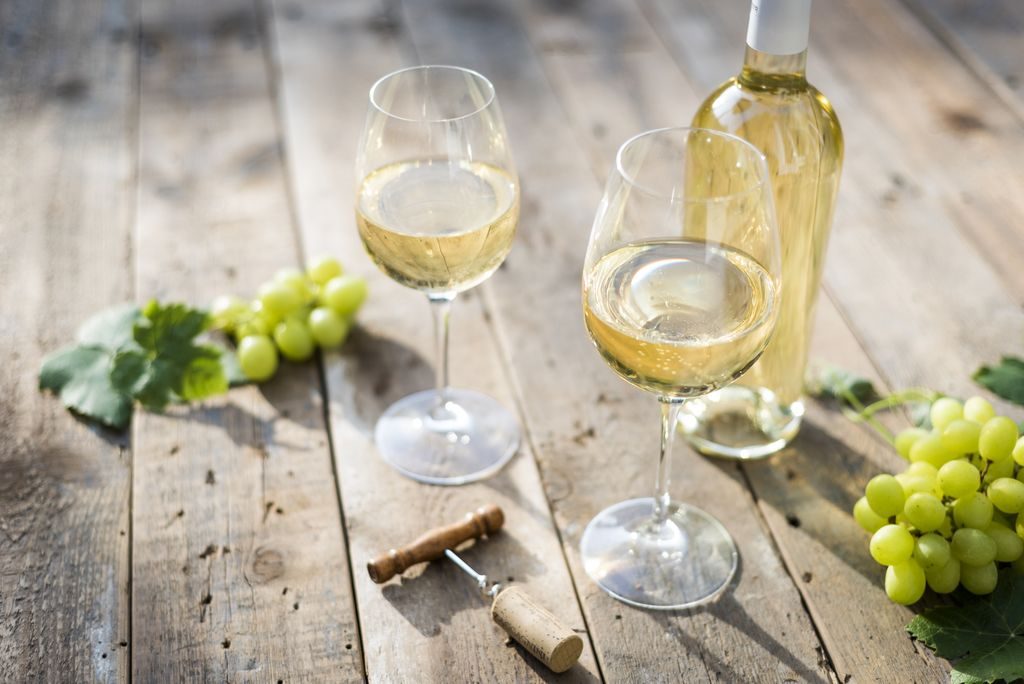White wine
White wine is a cold and refreshing alcoholic beverage that goes well with seafood and poultry.

White wine is an alcoholic drink made from fermented grapes. White wines are commonly paired with fish, shellfish and chicken dishes as they tend to have a more delicate flavour in comparison with red wines. White wine is also commonly used in cooking.
The difference between white wine and red wine lies in how the wine is produced. You may be surprised to learn White wine can be made form both white and red grapes, the difference is that after the grapes are pressed both the skin and the pulp are removed – leaving only the juice to ferment.
Making red wine is a little different, not only are the skins left on but the pulp and even the stems are sometimes left in while fermenting. This gives the wine its colour and a more robust taste.
Types of white wine
There are over 10,000 different varieties of wine grapes in the world. With such a staggering amount of grape variety, there is no wonder why there are so many different kinds of wine! With so much to chose from its difficult to know where to start.
Wines are either named after the type of grape used to make (Chardonnay, Pinot Grigio and Riesling) them or the region they come from (like Burgundy and Champagne)
The important thing to remember is that any wine you like is a good wine, that’s the first step! The next is to learn a little about the terminology so you can confidently explore other types and broaden your horizons!
Sweetness
Every wine, no matter if it is red, white or rose is defined by its level of sweetness. During fermentation, the natural sugars in the grapes are converted into alcohol. The sugars that are left are called ‘residual sugars’ and these sugars affect the taste of the wine. Wines are usually described as dry, semi-dry or sweet, here is what they mean…
- Dry – When you hear a wine described as dry it means it has a low residual sugar level, the taste will be crisp and sharp. Most Sauvignon Blancs tend to be dry.
- Semi-dry/Off-dry – These wines have a delicate sweetness as they have some residual sugars left. Semi-dry wines tend to be more full-bodied and have more complex flavours.
- Sweet – When a wine is described as sweet it means that a lot of the sugars have been left unfermented. These wines tend to have a low alcohol content.
Sparkling wines
Sparkling wines are made by a second fermentation process, this is achieved by adding a little yeast or sugar to still wine to encourage the production of carbon dioxide. They can be enjoyed at any time but they are regularly associated with special occasions like weddings, anniversaries, birthdays and big swanky parties.
- Champagne – When you think of sparkling wine you think of champagne. It is produced in the French region of champagne using the ‘Traditional method’. This method involves a second fermentation in the bottles. True champagne can only be produced in this region using this method. Due to its exclusivity, it tends to be the most expensive type of sparkling wine. Champagne is very fizzy with small ‘tight’ bubbles and it usually has a light and crisp taste.
- Cava – Like champagne cava is produced using the traditional method but it comes from Spain. Its made from completely different grapes but ends up tasting very similar to champagne but you can buy it at a fraction of the cost.
- Prosecco – Now we come to the cool Italian cousin, prosecco! Prosecco tends to be softer, than champagne and cava, the bubbles aren’t as tight and lively. This is because it is made with the’ Charmat method’. This method involves a second fermentation in large tanks rather than in separate bottles. Prosecco is originally from the region of Veneto and it only made with glera grapes. Prosecco is used to make the classic cocktail Aperol Spritz
- Spumante – This sparkling wine also comes from Italy – the Piemonte region in particular – but it can be produced all over the country. It can be made with both the Charmat and the Traditional method.
How to serve white wine
Contrary to popular belief white wine should not be served at an ice-cold temperature! Sparkling wine, on the other hand, should be served slightly cooler.
- Still white wines – 7 to 13 ̊ C
- Sparkling white wines – 6 to 10 ̊ C
A pro tip is to pop your bottle in the fridge 30 minutes before serving, This cools the bottle down without chilling it. Add sparkling wines to the freezer for 20 minutes before serving.
How to use white wine in cooking
White wine can be used in marinades, stews, risottos and pasta sauces.
White wine sauce goes fantastic with pan-fried chicken, simply use some wine to deglaze the pan add some flour to thicken the sauce and finish it off with a good splash of either double or single cream. You can easily swap the chicken for some mushrooms.
White wine is also amazing with mussels. Moules Marinière (of mussels in Marinière sauce) is a classic French recipe you can make in under 10 minutes! Not only that but mussels are economically priced and a sustainable shellfish!
White wine is also used to make white wine vinegar, perfect for salad dressing and marinades.
White wine nutritional information
White wine has about 82 calories per 100 grams, a large glass (250ml) of medium dry white wine is has about 190 calories.
The alcohol content varies from product to product but it usually ranges between 11 to 14%. There are about 10 units in a bottle of wine.
Alcohol should be consumed in moderation, the UK Chief Medical Officers recommend adults do not regularly drink more than 14 units per week. According to some recent studies, there may be some benefits to consuming white wine in small amounts as it contains some antioxidants that attack free radicals in your body.
You should not consume any alcohol if you are pregnant or under the age of 18.
Recipe suggestions: Lasagna, Bolognese sauce (Ragu)




